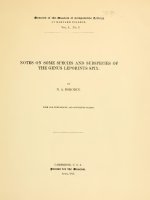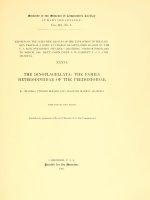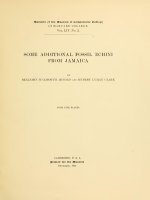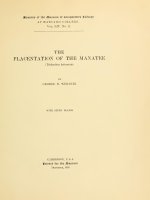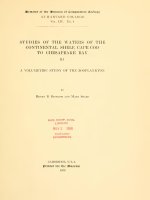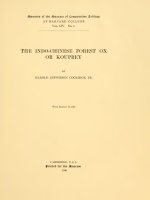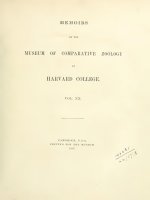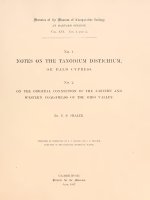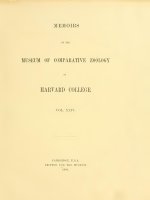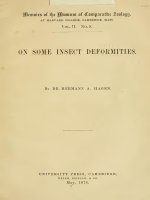Memoirs MCZ 5003
Bạn đang xem bản rút gọn của tài liệu. Xem và tải ngay bản đầy đủ của tài liệu tại đây (3.07 MB, 59 trang )
Memoirs
of tbe
nDuseum
of
domparative ZoSlogy
at harvard college.
Vol. L. No. 3
NOTES ON SOME SPECIES AND SUBSPECIES OF
THE GENUS LEPORINUS SPIX.
BY
N. A.
BORODIN.
WITH ONE TEXT-FIGtrRE AND SEVENTEEN PLATES.
CAMBRIDGE,
U.
S. A.
printcD for tbc flDuscum.
April, 1929.
NOTES ON SOME SPECIES AND SUBSPECIES OF THE
GENUS LEPORINUS SPIX
By N.
a. Borodin
INTRODUCTORY REMARKS
The Thayer
Expedition under the leadership of Professor Louis Agassiz
(1865), secured such a rich collection of Brazilian fresh-water fishes that
it
served
as the principal material for several capital ichthyological works on the Chara-
and Siluridae by Baron Dr. Franz Steindachner of Vienna, and by Dr.
C. H. Eigenmann of Bloomington, Indiana. Four volumes by the latter on Chara-
cinidae
Museum
have already been published by the
cidae
the fifth volume
now
is
of
Comparative Zoology, and
nearly prepared for publication.
Steindachner began to stud.y the collections at the
Zoology
in 1870,
being engaged
there until the end of 1871,
tion around South
Museum
work by Professor
for that
when he took
of
Comparative
L. Agassiz.
He worked
part, with Agassiz, in another expedi-
America on the steamship Hassler. He could not complete
the study of these vast collections during his stay at Cambridge, and did not do
so until later at the Vienna
duplicates.
Museum, which had
(See introduction to Steindachner's
received a rich assortment of
work "Die
Siisswasserfische des
Akad. Wissensch. Wien. 1874, 69, Abth. 1, s. 508.)
order to pick out duplicates, it was necessary to know the identity of
Siidostlichen Brazilien," Sitzb.
But
in
the species, which was not the case at that time with regard to
South American
fishes.
Thus
the stock in the
unidentified fishes from that collection.
M.
many
groups of
C. Z. for years contained
many
There are authoritative testimonies of
two eminent ichthyologists, Steindachner and Eigenmann, concerning the richness and importance of the Thayer Collection of South American fishes. Steindachner considered
it
"without any exaggeration the richest and the most com-
plete in the world."
Eigenmann wrote in 1917: "The
Louis Agassiz and his assistants is the
expedition. Forty
lection of
years after
it
collection of fresh-water fishes
largest ever brought together
was gathered,
South American fresh-water
undescribed species and genera." (Pp.
fishes
4,
it
was
still
made by
by a
single
the most important col-
and contained a
large
number
of
3 of the introduction of the five-volume
LEPORINUS SPIX
270
work
H. Eigenmann on the .\merican Characidae,
1918; 3, 1921; 4, 1927; and 5 shortly to appear.)
of Dr. C.
43, 1, 1917; 2,
Fifty-two
new genera and three hundred and twelve
Mem.
^M. C. Z.,
species belonging mostly
to the subfamily Tetragonopierinae were established and described by Eigenmann. Upon completion of Steindachner's work, the subfamily Anostominae of
the Characinidae family was
still
not completely studied. It seems that this group
attracted the special attention of Professor L. Agassiz
who
ordered the drawings
of seventeen fishes of the genus Leporinus Spix, to be prepared in advance, but
they were not published because of Agassiz's death in 1873.
These drawings,
together with fragmentary rough drafts on different species of the genus Leporinus
by the
late
Dr.
Mr.
S.
Garman were found
Thomas Barbour
Leporinus of the
M.
in the
museum
after his death in 1927.
invited the writer to study the collection of the genus
C. Z. in connection with Carman's notes and the above-
mentioned drawings. The present paper is the result of this study. It contains a
description of five new species, of which one is named for the late Mr. Garman,
and three new subspecies.
New
Species:
Leporinus thayeri
"
"
garmani
crassilabris
"
cylindriformis
"
New
jamesi
Garman
Subspecies: Leporinus fasciatus altipinnis
"
"
tigrinus
"
One
of the
new
crassilabris bremceps
species, Leporinus jamesi
Garman,
is
credited completely to
Mr.
Garman, because the specimen, which served for the drawing and the fairly good
description, has not yet been found in the museum's collections. It is probably
only misplaced in the shelves for Dr. Barbour remembers having seen
it
recently.
Mr. Garman's notes on the several forms, although merely rough drafts, sometimes hardly legible and in no way completed for publication, gave, however, a
guiding thread for finding the specimens on which the drawings and notes were
based. These have been accurately determined.
All these
and
allied
specimens have been studied and measured, and on the
newly made measurements, the descriptions of the new species and
subspecies has been made. The bibliographical references, which were carefully
basis of these
SYSTEMATIC ACCOUNT
271
compiled by Mr. Garman, have been of great value to the author. Unless otherwise indicated,
all localities
Gratitude
M.
C.
mentioned are
in Brazil.
Thomas Barbour,
herewith expressed to Dr.
is
Director of the
having found these notes and for having intrusted
Z., for
this interesting
task to the writer.
Key
to the
species of Leporinus described in this paper
compressed, depth from 3 to 5 in body's length anal with 10-11 rays;
attached to the isthmus.
a.
Bod.\'
Mouth
b.
inferior or subinferior, obviously pointing
cc.
.
.
.
1.
,
Mouth low,
bb.
L. 7normyrops Steind., p. 271,
2. L. gammed n. sp., p. 272,
pi. 1.
pi. 3.
not pointing downward.s.
Snout obtuse,
Snout oblong,
d.
dd.
membranes broadly
downwards.
Snout short, obtuse
Snout long
c.
gill
;
lips
moderate, teeth f
lips large fatty, teeth
,
f
4.
.
.
3. L. thayeri n. sp., p. 273,
L. crassilabris n. sp., p. 274,
pi. 2.
pi. 4.
Mouth terminal.
e.
Body covered with
bbb.
black markings of different shapes.
3-4 round spots on the anterior portion of the lateral line; lower teeth long, curved
much produced
L.friderici (Bloch), p. 275, pi. lb.
2-4 round spots along the lateral line and several bars on the back; teeth truncate on
both jaws
L. naltereri Steind., p. 277, pi. 11.
10 black cross bands encircling the body; scales very small (41-44 in lat. line)
/.
ff.
///.
L. fasciatus C. V., p. 277,
pi. 6.
Three black blotches on the anterior portion and a continuous longitudinal stripe along
the posterior portion of the lateral line ending on the c^iudal scales large.
ffff.
;
Back, dorsal, anal and pectoral
fffff-
L. jamesi Garman, n. sp., p. 281, pi. 9.
without black markings; teeth on both jaws truncate.
Snout obtuse, head broad, lower teeth produced
.L. pachyurus Gnthr., p. 282, pi. 14.
Snout conical, lower teeth not produced.
Body
ee.
g.
in adults usually
.
gg.
h.
Body verj'
Body deep, 3f teeth f
Body less deep, 5; teeth f
;
hh.
aa.
with dusky
fins
L. mulleri Steind., p. 281, pi. 12.
bars; scales small.
deep, depth 2j; anal with 13-14 rays;
gill
.
.
L. eonirostris Steind., p. 284, pi. 5.
L. margaritaceiis Gnthr., p. 286, pi. 13.
membranes narrowly attached to the isthmus.
L. hypselonotus Gnthr., p. 287, pi. 17.
(Syn. Abrandtes hy pselonolus Fowler).
aaa.
Body not compressed,
i.
a.
Remark:
slightly rounded, thick.
Depth 4 J; scales small
Depth about 3, scales large
— The length
to the base of the caudal
1.
Steindachner
M.
River.
D.
of the
L. cylindrijormis n. sp., p. 288, pi. 10.
L. bahiensis Steind., p. 289, pi. 16.
body
is
always taken from the
tip of the
snout
fin.
Leporinus mormyrops Steindachner
Fr. 1875, Sitz. Ber.
Wien. Akad., 71,
p. 240, pi. 6.
C. Z. No. 20,366, six specimens, size from 99 to 140 mm., from Parahyba
One
12,
Body
of these specimens is
A. 10 (11) V. 9; L.
;
1.
drawn on Plate
36-37 transv.
;
1.
1.
4^-31; teeth
f.
elongate compressed, upper outline moderately curved from snout to
LEPORINUS SPIX
272
Depth
dorsal.
21,
4;
head convex above and concave below, 4f
Mouth
produced and curved.
in
body; eye
opening downward.
inferior,
5,
snout
Teeth short,
narrow, dark-edged, eight in each jaw.
Fins shortish, anal not reaching halfway to caudal, pectoral hardly reaching
halfway to ventral.
and broad. Brighter central portions of scales and darker
edges thereof form vittae. Young have faint transverse bands of brownish; these
Scales rather large
disappear with the adults.
This
is
a well-defined form, and can be very easily distinguished from
however, the three allied species
I except,
other species.
many
described below,
which agree in having a peculiar form of head and inferior mouth opening downwards. L. mormyrops can be considered as the type for a subgenus with the name
Hypomasticus, which indicates the said peculiarity of the form and of the position
of the
mouth, common to the species L. mormyro'ps and L. garmani, and not ob-
served with numerous other species of Le-porinus.
L. mormyrops
is
represented in the
by the following specimens
M.
C. Z. collection, besides No. 20,366,
:
mm. long, from Santa Clara,
140 mm. long, from Parahyba River.
20,425, one specimen, about 150
20,764, one specimen about
These three collected by the Thayer Expedition, 1864. No. 20,369, one specimen
about 118
mm.
long,
from Parahyba River, collected by the Hassler Expedition,
1872.
It is a rather small-sized fish.
tained well-developed eggs.
Our
long.
slightly
A female specimen
135
mm.
Steindachner's types were at the utmost 200
description of this species in the collection of the
from that of Steindachner,
in our specimens are 36-37,
2.
Specific characters:
pi. 3, fig. 5);
mouth
long already con-
in that the
number
M.
mm.
C. Z. differs only
of scales in the lateral line
whereas he states them to be 38-41.
Leporinus garmani
sp. nov.
— Snout very long, 2f in head and of peculiar form (see
subinferior; teeth, six broad-edged
on the upper, and
six
pointed on the lower jaw scales rather large.
;
D. 12; A. 10; V. 9; P. 18; L.
Description of the
lected
34; transv. line |; teeth
type specimen M.
by Hartt and Copeland
Brazil (Plate 3).
1.
of the
C.
Z.,
|.
No. 20,420, 108
Thayer Expedition, 1865,
mm.
at
long, col-
Arassuachy,
SYSTEMATIC ACCOUNT
Body
273
and compressed, depth 4j in length, head narrow,
bod3\ Snout long, 2f in head, blunt and very peculiar in form. Eye
elongate, slender
pointed 4i in
Mouth
large, 4 in head, 2 in snout.
Teeth shortish, 6 on the
small, subinferior.
upper jaw and 8 on the lower. Those on the upper jaw
broad-edged, the two
all
middle ones with a semilunar notch. Those of lower pointed, the two middle ones
much
larger
and
slightly
curved (see
All the teeth are tipped with
fig. 4, pi. 3).
dark yellow excepting hindmost of lower jaw, which are small and white. Fins
comparatively short with the exception of caudal, which
deeply forked and
is
its
lobes are very long, longer than head.
Scales large, with
lowish,
marked
Coloration silvery to
striae along the middle.
no black markings except diffused group of brown punctulations
j^el-
in the
middle of the base of caudal.
In the form of the snout,
it
resembles L. mormyro-ps, Steind., from which
it
can
be easily distinguished by the position of the mouth, the dentitionand squamation.
3.
Specific characters:
eight dark
Lepohinus thayeri
sp. nov.
— Snout blunt, rounded, mouth low but not subinferior;
amber teeth on each jaw;
lips fringed;
dorsal high; caudal deeply forked, upper lobe
paired fins and anal shortish;
somewhat
longer, as long as body's
depth; adipose tipped with dark brown, no markings on the bodj'.
D.
12; A. 10; V. 9; P. 17; L.
Description of the type
37; transv. 1.-^; teeth
specimen M.
by the Thayer Expedition
lected
1.
in
C.
f.
No. 20,364, 134
Z.,
Parahyba River (Plate
mm.
long, col-
2).
elongate, compressed, depth almost equal to head's length, 4 in body.
Body
Head subcorneal, compressed, crown high
tudinally, 45 in body; eyes of
moderate
size,
head. Snout blunt, rounded, 2\ in head;
inferior as
in transverse arch nearly straight longi-
4§ in head, situated in mid-length of
mouth
small, situated low, but not sub-
with L. garmani.
Teeth, eight in number on each jaw, upper incisors truncated, without any
notches, lower slightly pointed.
large,
All of
4 rows above and 3 below lateral
dark-amber
line,
color;
37 along lateral
Fins rather small with the exception of dorsal which
depth; and caudal, which
is
is
Scales
line.
is
high, li in body's
deeply forked with sharp ended lobes, the upper,
longer lobe being as long as body's depth.
(brown), which
hps fringed.
Adipose
omitted in the drawing of Plate
2.
fin
No
tipped in dark amber
other dark markings on
the body.
This species can be easily distinguished from
its relatives,
from L.
conirostris
LEPORINUS SPIX
274
by having an obtuse snout, from L. nasutus by the shorter snout and higher position of mouth from many others by the absence of any markings on the body and
;
by the dark-tipped
adipose.
There are several more specimens of this species in the collection of the
M. C. Z., namely: one paratype, No. 20,364a (in the same bottle) from Parahyba
River; No. 20,.367, five specimens, 140-160
by the Hassler Expedition; No.
collected
from Rio
]\Iuriahy, a tributary of the
Copeland
of the
mm.
long,
from Parahyba River,
20,414, one specimen, 159
mm.
long,
Rio Parahyba, collected by Hartt and
Thayer Expedition.
Leporinus crassilabris
4.
— Large,
Specific characters:
sp. nov.
thick, papillose fleshy lips; long head, 3j in
body, depressed on the top, humpbacked pectorals long, reaching base of ventrals.
;
D. 12; A. 10; V.
9; P. 17; L.
1.
Description of type specimen
37; transv. series 4i-3i; teeth
M.
C. Z. No. 20,423, 90
mm.
f.
long, collected
by
Hartt and Copeland of the Thayer Expedition, in Rio Jaquitinhonha, Brazil
(Plate
4).
Body
depth 3| in body. Head long, greater than depth of
slightly elevated,
body, 35 in body. Crown longitudinally concave. Eye 4 in head. Snout long, 2^
in head. Mouth-level low.
Lips large, very thick, soft and fleshy, the upper pro-
truding far over lower one. Teeth short, six on each jaw, the upper
all
broad two
;
obUque points near inner edge and a feeble
lower also broad and supplied with oblique
larger ones in front supplied with short
Two
notch near the outer.
frontal
points rounded on the apex.
They
are bright yellow.
Fins comparatively long,
pectorals reaching the base of ventral.
Scales large, in four entire rows above
have longitudinal
with
striae near their
and three below
lateral line.
They
middle and their hind two thirds are covered
silver.
The
tj'pe
specimen, which
is
undoubtedly a young one, has nine dusky cross
and not complete, some of them forming Aague dusky
blotches. These bands and blotches are absent in larger specimens 345-420 mm.
bands which are
faint
long, which, moreover,
and more protruding;
show other
in a
differences.
specimen 380
mm.
much more fleshy
the upper lip is 20 mm. longer
Their Ups are
long,
than the lower one; this results in altering the whole form of the head which looks
hke a short trunk
(see fig. in the text).
pointed), probably from
long,
M.
much
Their teeth are nearly truncate (not
wear. For comparison, a large specimen, 380
mm.
C. Z. No. 20,422, paratype, has the following measurements: head 3i,
SYSTEMATIC ACCOUNT
depth
all
4,
snout 2^, eye
Another specimen, 295
8.
275
mm.
characters of the larger specimen. This species
is
long,
No. 20,422a, repeats
known
only from the river
Jaquitinhonha, eastern Brazil, running direct to the Atlantic Ocean. The adult
H. Saunders
Ftg.
1.
— Leporinus crassilabris Borodin.
X
No. 20,422.
can be readily distinguished from
|.
other species by
all
its
large thick lips
peculiar form of the head, characters which are not so striking on the
specimen shown
in Plate 4.
large specimen of L. crassilabris,
from Rio Arassuahy, has
short head which
snout 2j; L.
color.
C. Z. No. 20,419, 360
mm.
long,
most important character of the
considerably from them by having a
differs
contained 4 times (not 31) in body's length. Depth 3J; eye
35-.36; transv.
1.
4^.
Teeth
f,
short, truncate, of dark
amber
Lips large, papillose. Scales very large and broad. Their margin well cov-
ered with
A
1.
is
M.
large, fleshy lips, the
type and paratype of this species, but
8;
young
Leporinus crassilabris breviceps, subsp. nov.
4a.
One
and
silver.
perfectly preserved specimen collected in 1865
by the Thayer Expedition.
Leporinus friderici Bloch
5.
f!almo friderici Bloch, 1793, Naturgesch. Ausland. Fische Atl., fig. 378.
Curinatus acutidens Valenciennes in D'Orbigny's Voyage dans I'Amer. merid., Poissons,
LeporiniLS frederici
D. 12
(13)
Cuvier & Valenciennes,
;
A. 10 (11)
;
pi. 8, fig. 1.
22, p. 2.
V. 9-10; L.
1.
37-39; transv.
1. i;
teeth
g!^
(Plate 16).
LEPORINUS SPIX
276
Body moderately compressed, deep and arched in front of the dorsal, depth
3i. Head short, pointed at snout, about 4 in body. Eye small, 4^ in head, situated nearer to the snout than to the opercle. Mouth small, anterior cleft very
short, lips moderate, papillose. Teeth, eight
on the upper jaw, truncate on edge;
those on the lower jaw are in most cases also eight in number, but sometimes
only
much
they are long, narrow, curved, sharply pointed and
six;
produced. In
the adults, however, they are short, partly truncate probably as the result of
It
wearing.
might be worth while to mention that the teeth of Leporinus
general, recall the incisors of mouse-like rodents, which
is
in
probably in close con-
nection with the fact that these fish are plant-eaters, and their teeth are liable to
be worn on the surface from use.
Dorsal moderate,
a
its
upper margin convex; pectoral and
\'entral small; anal
hind margin convex; caudal deeply notched, lobes rounded.
little larger, its
Pectoral reaches only half
way
to ventral; ventral,
when
stretched out, reaches
caudal rays. Three, sometimes four, large dark brown spots, roundish or oval, on
the lateral
A
line.
considerable difference exists between adult and young specimens of this
young the dark spots are more developed and there are about 14
cross-bars on the back which do not descend on the sides below the lateral
species; in the
faint
line ; their teeth
on the lower jaw are sharper and more produced, their caudal lobes
somewhat pointed, not rounded. On the other hand, many variations can be
observed in coloration and exterior forms in specimens collected in different rivers.
are
The drawing
(Plate 15)
is
made probably from a
large alcoholic specimen,
with no trace of the spots which are so characteristic of this species, as sho\\n in
the figures accompanying the original description by Bloch, as well as in Voyage
D'Orbigny
(see the reference above).
It
might also show more clearly another
diagnostic character of this species, the steep ascending of the upper outline from
head to dorsal
to figure
1
fin
and a deep body (depth 3j
on Plate
M.
body and not
3 ^ as
it is
according
15).
This species, evidently,
sented in the
in
is
a
common
fish in Brazilian waters.
C. Z. collections by very
many
It is repre-
specimens from the following
Gurupa, Lake Hyanuary, Javary, Tabatinga, Bahia, Goyaz, Iga,
Jutahy, Lake Aleto, Lago do Maximo, Obidos, Para, Porto do Moz, San Gongallo,
Santarem, Teffe, Montalegre, the Essequibo River, Surinam, and others. The
localities:
largest specimens of the collection
do not exceed 250
Museum listed by Dr. Steindachner
a maximum of 14 inches (350 mm.).
Vienna
(I.
c. Sitz.,
mm.
Specimens
in the
1875, pp. 247-248) reached
SYSTEMATIC ACCOUNT
L.
6.
277
NATTERERi Steind.
L. na/ZerfriSxEiNDACHNERFr., 1876, Sitz. Ber. Wien. Akad., 74, p. 114, pi. 12,
D. 12; A. 10
Body
;
V.
9,
P. 17; L.
1.
37-39; transv.
much compressed; depth
elongate,
large, 3^ in
dorsal.
(11)
1.
fig. 1.
U; teeth
f (Plate 11).
3^; peduncle high; head 3f; eye
head; snout deep; forehead profile concave, arched from nape to
Mouth
small, anterior; lower
jaw
little
Teeth |
longer.
thin, feeble,
chisel-shaped, truncate; those behind the incisors notched or serrated.
Scales
smooth, striae minute, hind edges membranous.
Their
large, thin, set close,
Some specimens have
central portion light, giving the appearance of vittae.
four,
some three spots on the
line,
described
lateral line.
The
silvery
by Steindachner and shown on
band along the
his drawing, is
lateral
faded on our
specimens.
Though resembling
by the
L. frider ici in color, this species
is
lection of
mm. long
Steindachner's type specimens were 90-127 mm. long.
long,
readily distinguished
and by the more compressed body. It is represented in the colthe M. C. Z. by No. 20,384, 3 specimens, 108 mm., 83 mm. and 82 mm.
dentition
from
Teffe,
and No. 19,825,
1
specimen, 94
Leporinus fasciatus (Bloch)
7.
Salmo Jasciatus Block, 1794, Naturgesch. Ausland. Fische, 8,
Leporinus noremfasciahis Agassiz & Spix, 1829, Select. Gen.
Lepormus fasciatus
from Santarem.
p. 96, 379.
ct Spec, pise, p. 65, pi. 37.
Muller& Troschell, 1845, Horae Ichthyologicae, 1, p. 11.
& Valenciennes, 1849, Hist. Nat. Poissons, 22, p. 34.
Leporimis fasciatus Cuvier
D.
12; A. 10; V. 10; L.
Body
1.
41-44; transv.
elongate, compressed; upper
in curvature;
head pointed,
of body, contained
its
|Ef ;
teeth f (Plate
and lower
length equal or
outlines not greatly differing
somewhat shorter than the depth
about 4 times in body. Eye 3| in head.
middle of the head.
6).
Its position
near the
Snout short, 24-3 in head. Jaws nearly equal, the lower
appears longer in the open
mouth because
of longer teeth.
Mouth
small,
an-
Teeth eight on each jaw; upper short, pointed; lower longer, pointed,
curved and produced. Scales rather small, thin, set close and firmly, varying
in number of rows from 41-44 rows in lateral line, from 5 to 8 above, and from
terior.
5 to 7 below the lateral
Fins of
its
medium
line, in
size.
transverse series between dorsal and ventral.
Dorsal shorter than head's length, caudal deeply forked
upper lobe contained 3^-4 in the body's length.
There are from 8 to 11 transverse bands
and the caudal, extending below the
of
brown
to black
lateral line: a black
between the head
bar across the inter-
LEPORINUS SPIX
278
These markings are subject, however,
orbital space, another across the snout.
number
to considerable variation in the
width as compared with
of bands, their
the interspaces, and in depth and color in the different subspecies.
Some
of these subspecies
example, L.
which,
affinis Giinther,
when compared with
have already been described as
C. Z.
by many specimens,
(Bloch) and other new subspecies, do
represented in the
L. fasciatus
not show clear specific characters.
M.
We give below
full details of all
Giinther's Catalogue of fishes of British
from the Essequibo River, Surinam and
;
11
;
L.
1.
42; transv.
Museum
(5, p.
308) based on specimens
—
Brazil, are as follows:
1. i.
Depth
itself.
they are summarized in
as
specific characters of L. fasciatus (Bloch)
D. 12; A. 11 V.
the subspecies
with comparative analysis thereof and the species
of L. fasciatus together
The
species, as for
31; head 4; the eye
is
some-
end of the operculum than to the extremity of the snout. Lips
the interorbital space;
fringed. Eleven blackish cross-bands: the first one across
the second on the nape of the neck, the third and fourth in front of the dorsal,
what nearer
to the
the sixth, seventh and eighth between dorsal and adipose
behind the adipose
fin,
Measurements
the eleventh on the base of the caudal
of the
specimen of L.
Obidos, from which the drawing, Plate
depth
4;
fins,
eye 3f snout 2f
;
;
lat. 1.
6,
fasciatiis,
M.
the ninth and tenth
fin.
C. Z. No. 20,443,' from
was made, are given below: head
4;
44, transv. 5i; teeth f lower long, sharp pointed
;
and curved. Eleven cross-bands on the body and head; behind the upper Up a
conspicuous dark semi-circle not marked on the drawing. Dorsal as high as the
body is deep at the vertical of its last fin, but shorter than the head's length.
Another specimen of /.. fasciatus (Bloch), M. C. Z. No. 20,434 from Lago do
Maximo, Brazil, measures 150 mm. long; head 4^; depth 4; eye 4; snout 2i;
L.
1.
44; transv.
1.
f teeth f the hindmost very small, appearing as
if
;
;
veloped, 2 lower in front \ery long, projecting, curved, of dark
just de-
amber
color.
There are 11 dark cross-bands as described by Giinther.
Specimens which can be considered as typical L. fasciatus (Bloch) are represented in the collection of the M. C. Z. from the following locaUties: Bartica,
Essequibo River, British Guiana and Gurupa, Iga, Jutuhy, Lago Alexo, Lago do
Maximo, Para, Porto do Moz, Tapajos, Villa Bella.
The
largest
specimen in the collection do not exceed 300
are about 150-170
The
of
them
mm.
following three varieties or subspecies of L. fasciatus (Bloch) can be
defined on the basis of the
»
mm. Most
There are eight specimens
in
M.
C. Z. collection:
a bottle, size from 83-60
mm. The largest was
taken for measuring.
SYSTEMATIC ACCOUNT
7a.
279
Leporinus fasciatus affinis Glint her
Plate 7
In Glinther's Catalogue this fish
rated as a separate species, characterized
is
as follows: "Closely allied to L. fasciatus but with fewer bands.
4|.
in the
Eye
cross-bands the
Depth
3|,
head
middle of the length of the head. Lips fringed. Nine blackish
first
across the interorbital space, the second on the nape of the
neck, the third and fourth in front of the dorsal, the sixth and seventh between
the dorsal and the adipose
caudal
fin.
fins,
the eighth and ninth between the adipose and
Fish from Para, River Capin, Brazil"
(5, p. .308).
Thus, the points of difference from typical L. fasciatus are: fewer cross-bands,
9 instead of
11,
and the position
of the
eye in the middle of the head. But the
of cross-bands varies partly with age, partly with locality,
number
intermediate forms can be found. Another confusing fact
band
is
is
and many
that sometimes one
partly divided in two in the upper or lower portion, and counting the
bands becomes uncertain.
The
position of the eye
many
ation of
specimens of this
lower part of the
Amazon
more importance, but closer examinform, which by the way come mostly from the
seemed to be
of
River, convinced us that this character alone cannot
serve to separate this variety from other specimens of L. fasciatus (Bloch).
ever, the
examination of large
series
shows that the
fish
How-
described as L. affinis by
Giinther can be maintained as a subspecies of L. fasciatus, characterized by a
smaller
number
of less defined cross-bands,
sometimes incomplete or even want-
more compressed body, shorter dorsal and caudal. These differences can
be readily seen on Plate 6 {L. fasciatus typical) and Plate 7 (L. fasciatus affinis
ing; the
Giinther).
Comparative measurements
of several specimens are given below.
LEPORLXrs SPIX
280
Specimens of L.
were collected
fasciatiis affinis
at
Gurupa, Pernambuco,
mm.
Porto do Moz, Santarem, Tajapura (largest specimens about 206
long),
Rio Tapajos, Rio Xingu, Cotinho, Garupa.
Leporinus fasciatus altipinnis, subsp. nov.
7b.
Plate 8
D. 12; A. 10; V. 10; P. 16; L.
The unique specimen
1.
41-42; transv.
The drawing
Form of body similar
head
|.
higher dorsal and longer caudal, which
still
more sharply pointed. Two specimens, 95 and 80 mm.
rana, Brazil.
4,
teeth
of altipinnis represents the extreme characters of the
subspecies affinis Giinther. It has a
are also
1. |:
4;
made probably from
to L. fasciatus (Bloch), but
less
eye large,
is
than 3 in head;
it is
long,
the specimen 80
somewhat more
situated a
little
from Jatu-
mm.
slender.
long.
Depth
nearer to the snout
than to the opercle. Dorsal and caudal are well pointed. Anterior rays of dorsal
a
little
longer than head's length; upper lobe of caudal SJ in the
Lower jaw not projecting; teeth
body depth.
f.
Eight dark cross-bands completely encircling the body, including one on the
neck; some of them dividing in two branches on the belly; 2 more on head, very
distinct
pose
is
on the
and
interorbital space
less distinct
black (not shown in the di'awing)
7c.
on the snout. The base of adi-
.
Leporinus fasciatus tigrinus, subsp. nov.
D. 12; A. 10; V. 10; P. 17; L.
This varietj' of L. fasciatus
1.
is
39-40; transv. f teeth
;
|.
represented in the collections of the
M.
C. Z.
by specimens No. 20,446 and 20,446a, 145 mm. long (both of equal size), from
Goyaz, Brazil. The characters of this variety are: body more robust, less compressed and somewhat rounded; depth 3j; head 4^; eye 3;; snout 2J. Ej^e situ-
ated nearer to the snout than to opercle. Eight cross-bands on the bodj' (including that on the neck)
;
four of
them
in the
two branch
less
conspicuous markings on the head.
Scales less
middle of the body, divided on the back
more
into
bands, resulting in a
numerous than with other
striped appearance of the back.
varieties.
Two
Teeth on the lower jaw, two
in front thin, long, sharp and produced, three others on each side are shorter;
on the upper jaw
six (not eight, as
with
all
other varieties) incisors.
This subspecies seems to be a most marked one, and might almost be con-
However, we prefer not to multiply the number of
new species without necessity, and rank it as a subspecies of L. fasciatus (Bloch).
sidered a distinct species.
SYSTEMATIC ACCOUNT
8.
Steindachneb
D.
Leporinus mulleri Steindachner
Fr., 1876, Sif z. Ber.
12; A. 10; V.
8; L.
I,
Wien.
.•Uiad., 74,
shortish, with exception of dorsal
much
set
it is
4;
which
way
I,
Ichthyologische Beit. V, p. 105,
pi. 9, fig. 5.
head
is
4; eye .Sj-S^; snout 2|-2|.
high;
its
longest ray
is
way to the origin
Fins
almost as long
nearer to the snout than the ventral fin and
rounded. Anal does not reach even half
reaches only half
Abth.
35; tiansv. t; teeth f (Plate 12).
1.
Body much compressed, depth
as the head;
281
is
well
of caudal rays. Pectoral
to ventral.
Scales rather large. Incisors of the upper jaw with cusps; on lower jaw, teeth
and curved. There are 12-14 narrow dark bars on the head and the
are sharp
back; three faint black blotches along the anterior portion of the lateral line and
a continuous longitudinal narrow stripe along the posterior portion of the lateral
line
and the caudal to the end
of its
middle rays.
A narrow silvery band along the lateral line could be traced on each specimen
examined by
us.
This species
specimens 80
is
mm.
represented in the
jVI.
C. Z. collections by: No. 19,479, two
long (both of the same size) from Teffe.
The drawing
from one of these specimens. No. 19,409, four specimens, 41,
long,
from Jutahy. No. 19,608, one specimen, 43
Their form and coloration
make
well correspond to the description
all
mm.
is
the smallest of
all
and 30 mm.
from Hyavary.
these specimens very typical, and they
by Steindachner, and the drawing accompany-
ing that description. His specimens were also of small
This
long,
38, 31
made
is
size,
not larger than 90
the species belonging to the genus Leporinus.
near to L. nigrotaeniatus Schomb., but differs from
it
by short anal
fin
and
mm.
It is
differ-
ent coloration.
Another small leporin
cited above,
tinguished
fig.
(size
under the name L.
85-100) described by Steindachner in the paper
agassizii,
resembles L. mulleri, but can be dis-
by higher body, longer head and somewhat
4 and 5 of Plate
12,
9.
accompanying
different coloration (see
this paper).
Leporinus jamesi Garman,
sp. nov.
Plate 9
D. 12;A. 10;V. 9;L. 1.45;transv.
1. i;
teeth
f.
Body compressed, head pointed, outlines subfusiform; head 4j and depth
3f times in the length to the fans of the caudal rays. Eye large 3t times in head,
11 times in snout. First ray of dorsal about
midway from snout
to base of caudal.
LEPORINUS SPIX
282
midway from snout to adipose. Upper and lower outlines nearly
curvature. The shape of the dorsal is somewhat Uke that of the 3i inch
Origin of dorsal
equal in
shown on Plate
of L. fasciatus
example
much
margins, but does not differ so
as
shown
is
in Plate
On
8.
the anal
in
amount and convexity of its
the length of anterior and posterior rays
fin,
6,
in the
however, the hinder rays of the
Mana-
capuru specimen are very short while the anterior are long, giving a shape more
like that of the same fin on Plate 8 (fasciatus) where the hind rays of the dorsal
and the anterior
are shorter
One
tus
is
most marked differences between the present species and L. fascia-
of
found
in the teeth:
whereas the incisors of L. fasciatus have a median angle
in the cusp, those oi jamesi
incisors
is
taller.
have a median notch, that
is,
the cutting edge of the
divided by a median notch, at each side of which
lateral teeth of the
upper and
is
a prominence.
The
the lower have cusps like those of L. fasciatus.
all
With regard to the coloration, while the transverse blotches are nearly the
same in number 10-11, they do not extend below the lateral line. Even on the
back they are
faint
and narrow. On the
On
noticed on other species.
fins there are
markings such as have been
the dorsal the proximal half, or basal half, has a
blotch that fades backward, and on the central rays near their tips there
other transverse blotch.
On
an-
the pectoral three transverse blotches appear in the
proximal half; and there are two similar bands on the anal
of the rays.
is
The markings and
fin
toward the bases
the dentition serve to distinguish this form from
the other fasciated species.
It
was
collected at
10.
Manacapuru by Dr. James.
Leporinus pachyurus Cuvier
&
Valenciennes
Plate 14
Leporinus pachyurus Cuvier & Valenciennes, 1849, Hist. nat. des Poissons, 22,
Leporinus brachyurus Castelnad, 1855, Anim. Amer. Sud, Poissons, p. 59, pi. 30,
Leporinus pachyurus GtJNiHER, 1864, Catalogue, 5, p. 308.
Leporinus leschenaulli Cuvier & Valencien-nes, loc. cit., p. 30, pi. 635, juv.
Leporinus leschenaulli GtJNTHER, Catalogue,
D.
12; A. 11; V. 10; L. 1. 40;
Body
short,
6, p.
1.
p. 36.
fig. 1.
307.
transv. f teeth
;
^.
depth 85 head short 3^ and broad in the front; eye 3; snout
;
3.
Teeth strong, entirely truncated on the upper jaw; two on the lower, long, thick,
and very much produced,
way
particularly in the young.
The
pectoral terminates half
or farther to ventral; both as well as anal, are short.
remarkable
Tail short, caudal
is
for the thickness of its rays.
Coloration of adults uniform, while the young, from one of which the accom-
SYSTEMATIC ACCOUNT
panying drawing
line
and several
made, have usually three large spots or blotches on the
is
faint cross-bars
There were 5 bottles in the
lateral
on the back.
M.
C. Z. labelled Leporinus lesdienaulti Cuvier
A close examination
and Valenciennes.
283
of their contents
and comparison with L.
and the description of the three allied forms (friderici, pachyurus
and leschenaulti) showed that the medium-sized specimens, 110-127 mm. long,
friderici (Bloch)
with faint spots are undoubtedly L. pachyurus Cuvier and Valenciennes, while the
specimens 55-105
same
species.
mm.
Thus
round black spots are young of the
Cuvier and Valenciennes and L. leschenaulti
long, with well-defined
L. lescfienaidti
Gunther are synonyms of L. pachyurus Cuvier and Valenciennes, being young
specimens of the same species. In this particular case, as with L. friderici, the
young differ greatly from the adults not only in coloration, but also in the sharper
and longer teeth (not worn down), larger eyes and some other minor characters.
These differences probably induced Cuvier and Valenciennes to describe a new
species L. leschenaulti, this description and the accompanying figure correspond
perfectly well with the smaller specimens of the
M.
C. Z. collection labeled as
namely No. 19,611, two specimens, 55 mm. from Javary, Brazil,
Thayer Expedition, and No. 20,449, one specimen, 105 mm., from Brazil, Hassler
L. leschenaultii,
Expedition.
Three others also labeled L.
leschenaultii,
No. 20,396, one specimen, 90 mm.,
from CJurupa, Thayer Expedition No. 20,392, one specimen, 110 mm. from Lake
Hyanuary, Thayer Expedition and No. 20,496, 127 mm. from Lake Araray,
Thayer Expedition, are spotless or with very faint blotches. All of them are L.
pachyurus and they much resemble L. friderici of the same size, which probably
induced Steindachner and Eigenmann to consider L. leschenaulti a synonym of
L. friderici (see Sitz. Ber. Wien. Akad. Sci., 71, 1875, p. 223 and
Mem.
Carn. Mus.
v. V. 1912, p. 303).
In order to verify this theory
I
made
parallel sketches of the
body
outlines
both species and their comparative measurements. The results of the comparison are as follows: specimens No. 20,449 L. leschenaulti ( =L. pachyurus) and
of
No. 20,436 L. friderici
of
about the same
size (105
and 110 mm.)
differ at a
glance
depth of body and head length; L. leschenaulti (=L. pachyurus) has the
body less deep, the belly outline A-ery slightly convex and a longer head with
pointed snout, while L. friderici has a deep body, strongly convex between head
in the
and
dorsal, a fairly
convex belly outline, and a short head with obtuse snout.
Specimens No. 19,611, L. leschenaulti {=L. pachyurus), 55
specimen No. 19,358, L. friderici 65
mm.
mm.
long, differs in exactly the
long and
same
respects
SYSTEMATIC ACCOUNT
as medium-sized specimens,
and moreover L.
285
leschenaulti has the lower teeth
more produced, so that they are never included when the mouth is shut. This
makes it easy to distinguish these two species in their younger stages. Comparative measurements of the same specimens, confirming the above statement,
present further particulars which ser\'e to separate them.
below
in
Table
I:
TABLE
I
They
are presented
LEPORIXUS SPIX
286
irregular faint cross-bands
on the
which partly bifurcate, and one more
sides,
pronounced spot on the base of the caudal than adults. Large specimens lose
the transverse bands, but a dark marking at the base of caudal remains. There
some
are also
description
is
mm.
from 79
differences in the relative dimensions of the
M.
based on the measurements of
mm.
to 117
drawn on Plate
long,
from Mendez,
body
parts.
The above
C. Z. No. 20,413, nine specimens
Brazil.
One
of these
specimens
is
5.
This species
represented in the collections of the
M.
C. Z. by
many
speci-
mens from Parahyba, Rio Doce, Porto Alegre, Mendez and Gurupa.
They
reach a
is
maximum
size of 13 inches.
12.
Leporinus margaritaceus Giinther
Leporinus margaritaceus Gunthek, 1864, Catalogue of Fishes of Br. Mus.,
D. 12; A. 11; V.
Head
lum than
10; L.
1.
5 depth 5 eye 4 in
;
;
39; transv.
body
;
it is
1.
a
f (Plate 13).
little
nearer to the end of the opercu-
The
rather narrow, the lower obliquely truncated.
of the snout equals that
reaching beyond the root of the caudal
309.
Lips rather thick, not fringed.
to the extremity of the snout.
from the extremity
6, p.
if
distance of the
from the adipose
laid
fin.
first
Teeth
dorsal ray
Anal rays long,
backwards. Coloration uniform,
each scale with a broad pearl-colored margin an indistinct yellowish band along
;
the side of
body and
tail,
below the lateral
line.
Giinther's type, 8| inches long,
from British Guiana.
This species
is
not represented in the
M.
C. Z. collections at the present time,
and the description above is taken from Giinther. Our drawing was made at the
same time as the drawings of all the other leporins, but probably the specimen
was borrowed.
species, L.
We
include
it
in this
paper for comparison with another
allied
pachyurus Giinther, and because Giinther's description of this species
was not accompanied by a drawing. It must be remarked, however, that there
are some discrepancies between our drawing and Giinther's description quoted
above (1. c, p. 309), namely: number of scales in lateral line 36 (not 39); depth
and contained only 3i
D. farther back from the snout.
greater than the head's length,
(not 5); the position of
drawing
is
L. margaritaceus from Garman's ms.
responding plates were indicated.
list
in the body.
We
Head 3j
conclude that this
of species in
which the cor-
SYSTEMATIC ACCOUNT
13.
287
Leporinus hypselonotus Giinther
Leporimis hypselonotus GtJNTHER, 1868, Proc. Zool. Soc. Lond., p. 244.
Abramites hypselonotus Fowler, 1906, Proc. Phila. Acad. Nat. Sci., p. 331.
D. 12; A. 13-14; V.
9; L.
38^1
1.
Body and head compressed,
;
transv.
1.
f teeth f (Plate 17).
;
short and deep.
Upper
outline concave at oc-
convex between head and dorsal, giving the impression of a humpback;
ciput,
lower outline convex from throat to caudal with a protrusion between the head
and
ventrals.
Head
Peduncle short and high.
small,
about 4^ in body; depth 2j; eye small, 4 in head; snout blunted,
Lower jaw the longer. Crown much arched
3 in head.
transversely.
Mouth small,
narrow, oblique anteriorly. Teeth on the upper jaw broad, bluntly pointed; on
the lower sharply pointed and supplied with a notch toward the outer edge (see
fig.
4)
.
The
their height.
Dorsal
anterior teeth are rather abruptly bent
backward
in the middle of
Gill-membranes feebly attached to the isthmus.
fin high,
the longest rays longer than head's length.
Base
more rays than dorsal (13-14). Pectoral
ventral. Caudal short, not too deeply forked.
longer than that of dorsal, with
reaching beyond the base of
of anal
long,
Coloration: on the silvery white ground color there are 8 broad transverse
bands of brown, 3 of them in front of the dorsal, one through the dorsal and the
ventral, 2 between ventral and anal, and 2 on the peduncle. Dorsal and ventral
with dark bars, base and tip of adipose black, the middle thereof white. The lower
Up
is
(not
shown
differs in
many
commonly black
This species
in the drawing)
characters from
Leporinus, and Fowler proposed for
generic character indicated
.
it
all
other species of the genus
a new genus, Abramites
by the author
is
(1.
c).
The only
the "larger anal basis." There are
two more important characters: (1) the gill-membranes, which with all other
leporins are strongly and completely attached to the isthmus, are only feebly
attached in L. hypselonotus;
Both
of these characters
very deep and shghtly humpbacked body.
(2)
show that
this particular species is intermediate
between
Leporinus and the subfamily Tetragonopterinae characterized by the absence of
the said attachment of the gill membranes to the isthmus and the high and broad
,
body.
However, we prefer to consider Abramites Fowler as a subgenus only,
because another species, L. eques Steindachner,
and there are some other groups
for
is
example L. mormyrops and L. garmani, which
could constitute another subgenus Hypomasticus.
the genus
is
made by somebody
very close to L. hypselonotus,
in the future,
it
When
will surely
a complete revision of
be divided into several
LEPORINUS SPIX
288
subgenera, without altering the familiar generic
name Leporinus
Spix for
all
the
described species.
This species
is
represented in the collections of the
mens, from 62 to 71
mm.
M.
C. Z. by nine speci-
long, collected at
Manacapuru, Brazil (No. 21,436).
They are all alike, very typical and perfectly drawn on Plate 17. The only thing
to be added is a very distinct black spot on the lower lip.
Giinther's specimen w-as 150
There
mm.
River).
only one slight difference in his description with ours, head 4^ in body.
is
10 rays in dorsal and 7 cross-bands.
Acad. Wien. 1878,
Leporinus eques Steindachner (Denkschr.
39, p. 40, taf. 10, fig. 2)
species to L. hypselonotus Giinther, but
2 5 in length), smaller scales (41-42 in
anal
Amazon
long from Xeberos (upper
it
from Rio Alagdalena,
differs in the less
1.1)
is
the nearest
deep body
and more numerous rays
(3
and not
(15) in the
fin.
Leporinus salarii Holmberg 1891, Rev. Arg. Hist. Nat.
long,
from Argentina
tion supplies nothing
14.
surely a
is
by which
synonym
64
mm.
of L. hypselonotus because the descrip-
to distinguish the species
Leporinus cylindriformis
— Body elongate,
Specific characters:
p. 187,
I,
slender,
from L. hypselonotus.
sp. nov.
upper and lower contours
of
body's outlines almost equal; anal long, reaching beyond the base of caudal,
truncate; caudal with short, well-rounded lobes. Scales small.
D. 12; A.
10; V. 9; L. 1. 44; transv.
M.
Description of a single specimen
at Porto
;
f.
C. Z. No. 20,430, 205
mm.
do Moz, Brazil, by L. Agassiz, Thayer Expedition (Plate
Head 4^ depth 4| eye 4 snout
;
This
fig. 3).
f teeth
1.
is
;
the slenderest species of the genus,
Snout moderate,
slightly blunted.
depth of body. Mouth anterior,
10).
2 J.
;
Its outlines are graceful, a
long, collected
body being nearly round
very low curve from end of snout to dorsal
Head
lips
subconical,
its
length
is
base of caudal,
with small papillae. Teeth on the upper jaw
rather high; anal long reaching,
its
fin.
more than
little
bluntly rounded, on the lower pointed and curved. Fins of moderate
dorsal which
(see
when
size,
except
stretched out, beyond the
end slightly concave; caudal moderately forked,
its
rounded and widely spreading ventrals and pectorals short, rounded.
Scales small; each scale partly silvery white and partly dusky,
lobes well
;
tudinal rows forming interrupted lines (see
are
shown only above the
lateral line.
lateral line,
fig. 1,
Plate 10).
but actually they
There are three oval duskv blotches on the
ai-e
their longi-
On the drawing they
also present
lateral line.
below the
SYSTEMATIC ACCOrXT
The single specimen in
the collection of the
seems to be very typical, and
differs
from
its
289
Museum of Comparative Zoology
nearest ally L. nigrotaeniatus Cuvier
and Valenciennes, by the absence of a very distinct and constant continuous black
longitudinal stripe along the whole posterior half of the lateral line to the base of
caudal,
and some other minor characters.
15.
Leporinus bahiensis Steindachner
Leporinus bahiensis Steindachner, 1875,
Sitz. Ber.
Wien. Akad., 71,
p. 231, Taf. 2, fig. 2.
D. 13
(12); A. 11; V. 9; L. 1. 32-36; transv. l.f; teeth f (Plate 16).
Body
robust, moderately compressed, back high, depth 21-3; head short
and
Forehead with a low transverse arch nearly straight longitudinally.
low 3^-4.
Snout blunt. Eye moderate, 3
in head; lower
jaw the longer. Teeth
six
on the
upper and eight on the lower jaw; they are pointed and two middle ones on the
lower jaw much produced; the hindmost teeth on the lower jaw very small, re-
duced to a
spine.*
Scales large. There are three large black formless blotches on
the sides on and below the lateral line in
its
posterior portion,
and several oblique
cross-bands on the back in young specimens.
This species, especially when j'oung, bears a strong external resemblance to
L. Jriderici (Bloch), but the squamation
and coloration are
are visibly larger, the peduncle longer, the head not so thick
large black blotches instead of one round spot
and
different; the scales
and
short. Formless
their different situation serve
from L.friderici (Bloch) and L. copelandi Steindachner.
Steindachner's original description and drawing were based on ten
also to separate
mens,
all
of
it
which were evidently young,
sizes
45-90
mm. The M.
speci-
C. Z. collection
consists of the following specimens:
No. 20,478, three specimens, 170-160 mm. from Rio Puty, Thayer Exped.
20,493, four specimens, 65-66 mm. from Bahia.
mm. from Rio Una.
138-155 mm. from Bahia.
2,417, three specimens, 225
1,191, three specimens,
1
Plate 16, fig. 4 shows eight teeth on both jaws, but this is exceptional. We examined teeth of four
they all have
specimens of No. 20,493, three specimens of No. 1,191 and three specimens of No. 2,417
teeth
on both
found
of
No.
was
one
the
and
teeth
on
six
20,478
having
eight
only
specimen
upper jaw
only
jaws. Thenumberof teeth does not seem to be entirely constant.
—
LEPORINUS SPIX
290
BIBLIOGRAPHY
Agassiz, Loris, an'D Spix,
J. S.
Selecta genera et species piscium quae in itinere per Brazilian! collegit J. B. de Spix.
1829.
Bloch, M.
Naturgeschichte der auslandischen
Cl'^'IER
fische.
Berlin, 1785-95.
AND VaLENX'IENNES
Histoire naturelle des poissons, 1849, 22, pp. 23-40, planche 635.
ElGENMANN, C. H.
Catalogue and bibliography of the freshwater fishes of the Americas south of the Tropic
of Cancer. Contrib. from the Zool. Lab. Indiana Univ., no. 76, p. 2, 1910.
The
The
fresh-water fishes of British Guiana.
Mem. Cam.
mus. 1912, 5, pp. 299-309, 3 plates.
Mem. Carn. mus., 1922, 9, no. 1,
fresh-water fishes of northwestern South America.
pp. 117-120,
1
plate.
The American Characidae. Mem. mus. comp. zool., 1917, 43, pt. 1.
Fowler, H. W.
Further knowledge of some heterognathous fishes, pt. 1 Proc. of Acad,
.
of Nat. Sci. Phila-
delphia, 1906, 58, pp. 293-351.
S.
GiJNTHER,
New species of fish
Catalogue
from Essequibo. Ann. and mag. nat.
of the fishes in the British
Museum,
5, p.
hist.,
1863, 12, p. 443.
306.
HOLMBERG, Ed.
Sobre algunos peces nuevos o poco conocidos de
1891,
1, p.
la
Rep. Argentina.
Rev. Arg.
hist. nat.
187.
J. A.N'D TrOSCHEL, F.
Horae ichthyologicae, pts.
MiJLLER,
Norman,
J.
1
and
2,
pp. 10-11, plate
1, fig. 7.
R.
Description of nine
new freshwater fishes from French Guiana and
Brazil.
Ann. and mag.
nat. hist., ser. 9, 1918, 18, pp. 91-95.
Regan, T.
The classification
of the teleostean fishes of the order Ostariophysi 1. Cj-prinoidea (Chara-
ciniformes included). Ann.
SCHOMBURGK, R. H.
The natural history
and mag.
nat. hist., ser. 8, 1911, 8, pp. 13-32.
of the fishes of Guiana, 1841.
Spix, J. B.
See Agassiz, L.
1829.
Steindachner, Fr.
Die Siisswasser-fische des sudostlichen
Braziliens.
Sitz.
Acad. Wiss. Wien., 1875, 71, pp.
216-245.
Ichthyologische beitrage, Sitz. Acad. Wiss. Wien., 1876, 119, pp. 105-117, 1910 (pp. 265272).
Ueber neue Characinerarten aus dem Orinoco und dem oberen Surinam.
Sitz. 1910, 119, abth. II b, heft. I and II, pp. 268-270.
Valenciennes, A.
In D'Orbigny, Voyage dans L'Amerique Meridionale. Poissons,
pi. 8, fig. I.
EXPLANATION OF THE PLATES
